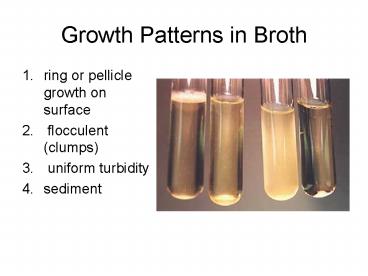Growth Patterns in Broth - PowerPoint PPT Presentation
1 / 9
Title: Growth Patterns in Broth
1
Growth Patterns in Broth
- ring or pellicle growth on surface
- flocculent (clumps)
- uniform turbidity
- sediment
2
Colony morphology
1. Colony shape and size round, irregular,
punctiform (tiny)2. Margin (edge) entire
(smooth), undulate (wavy), lobate (lobed)3.
Elevation convex, umbonate, flat, raised4.
Color color or pigment, plus opaque,
translucent, shiny or dull5. Texture moist,
mucoid, dry (or rough).
3
Bacillus Proteus
4
Staphylococcus Streptococcus
5
Motility agar stab agar with wire, not loop
6
Mannitol Salt Agar
- Purpose Mannitol salt agar is both a selective
and differential growth medium. It is used to
differentiate pathogenic Staphylococcus species
from nonpathogenic members of the genus
Micrococcus. - Principle Mannitol salt agar can help determine
two characteristics of bacteria, whether they are
salt tolerant or not, and whether they are able
to ferment mannitol. - Salt Tolerance (Does it grow?). This medium
contains 7.5 salt and therefore "selects" for
organisms that are able to tolerate the presence
of high levels of salt.If the organism grows, it
is salt tolerant.If the organism does not grow,
it is not salt tolerant.Therefore, we say that
MSA is "selective," as it will "select" for
salt-tolerant organism.
7
MSA continuedsalt/mannitol fermentation
- S. aureus /- (yellow)
- S. epidermidis /-
- M. luteus -/na
8
MacConkey Agar
Purpose MacConkey agar is a widely-used culture
medium which is both selective AND differential.
The medium is primarily used to differentiate
between Gram negative bacteria while inhibiting
the growth of most Gram positive bacteria. The
medium also differentiates between
lactose-fermenting coliforms and lactose
nonfermenters, which include potential
pathogens. Principle Addition to the nutrient
agar base of bile salts and crystal violet will
inhibit the growth of most Gram positive
bacteria, making MacConkey agar selective.
Lactose, a fermentable carbohydrate, and neutral
red, a pH indicator, are added to differentiate
the lactose positive coliforms from the
potentially pathogenic lactose nonfermenters. Addi
tional Information When lactose is fermented,
acid products lower the pH below 6.8, with the
resulting colonial growth turning pinkish-red. If
an organism is unable to ferment lactose, the
colonies will be colorless.
9
Mac continued
Staphylococcus aureus
Enterobacter cloacae on MacConkey Agargrowth
with pink colonies
Eschericia coli on MacConkey Agargrowth, with
pink colonies

